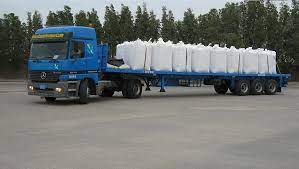There are many ways to safely transport raw materials, and the best method will depend on the type and quantity of material being transported. Here are some safe transportation methods:
Truck
There are many different types of trucks that can be used to transport raw materials, and each type has its own advantages and disadvantages. The most common type of truck is the flatbed truck, which is well-suited for carrying large loads. However, flatbed trucks are also more likely to spill their load, so it is important to secure the load properly. Another type of truck that can be used is the dump truck, which is designed for transporting loose materials such as sand or gravel. Dump trucks are less likely to spill their load, but they are not as versatile as flatbed trucks and can only be used on smooth surfaces. When choosing a truck for raw material transport, it is important to consider the size and type of the load, as well as the terrain over which the truck will be traveling. By taking all of these factors into account, you can choose the best truck for the job and minimize the risk of spillage or accidents.
Wheel loaders
Wheel loaders are one of the most versatile pieces of heavy equipment on a construction site. They can be used for a variety of tasks, including transporting raw materials, clearing debris, and excavating. Wheel loaders come in a variety of sizes and shapes, making them well-suited for a wide range of applications. If you’re in the market for a wheel loader, there are a few things to keep in mind. First, consider the size of the job you’ll be using it for. Second, think about the type of terrain you’ll be working on. Third, evaluate your budget. Wheel loaders can be a costly investment, so it’s important to find one that fits your needs and budget. There are many reputable dealers that sell wheel loaders in Arizona, so finding the right one should be relatively easy. With a little bit of research, you’ll be sure to find the perfect wheel loader for your needs.
Train
Trains are an efficient way to transport large quantities of raw materials over long distances. They can carry a lot of weight and are relatively slow, so there is less risk of accidents. It is important to secure the load properly to avoid spills or accidents. The train company will usually have specific instructions on how to do this. In general, it is best to use straps or ropes to tie the materials down. If possible, it is also a good idea to cover the load with a tarp to protect it from the weather.
Ship
Ships are a vital part of the international transportation system, and they play a crucial role in the movement of raw materials around the world. Ships come in a variety of sizes and shapes, but all are designed to move large volumes of cargo efficiently and safely. Before loading raw materials onto a ship, it is important to make sure that all containers are properly labeled and sealed. This will help to ensure that the materials arrive at their destination in good condition. Once the raw materials are on board, the ship will set sail for its destination. Depending on the distance involved, the journey can take days or weeks. During this time, the ship’s crew will take care of the cargo, making sure that it is properly stored and protected from the elements. When the ship finally reaches its destination, the raw materials will be offloaded and ready to be used in manufacturing or other applications.
Airplane
Airplanes can be used to transport raw materials, but care must be taken to avoid damage to the material during loading and unloading. The main concern is that the material will be damaged by the high air pressure in the cargo hold. To avoid this, the material must be properly packaged and secured. In addition, the airline must have a policy in place for handling damaged or missing cargo. If the material is properly packaged and secured, and the airline has a good policy in place, then airplane transport can be a safe and efficient way to move raw materials.
Pipeline
Pipeline transportation is a critical infrastructure for the movement of liquids and gases. Pipelines can be used to transport liquids or gases over long distances. Proper maintenance and inspection of pipelines are essential to ensure the safety of the transported materials, as well as the surrounding environment. Before use, pipelines must be inspected for cracks, leaks, and other damage. If any damage is found, the pipeline must be repaired or replaced before it can be used again. In addition, regular maintenance is required to prevent future problems from occurring. By properly maintaining and inspecting pipelines, we can ensure that they remain




